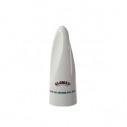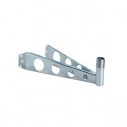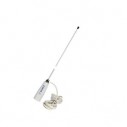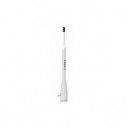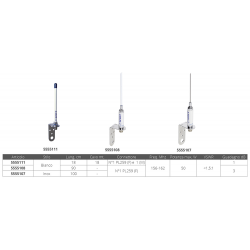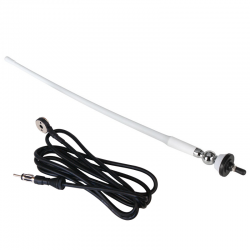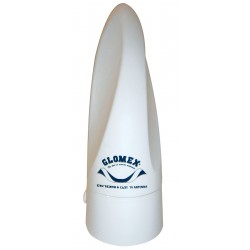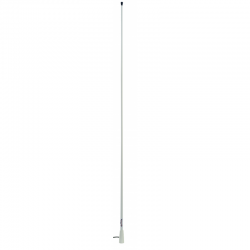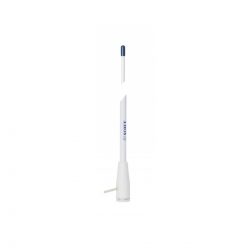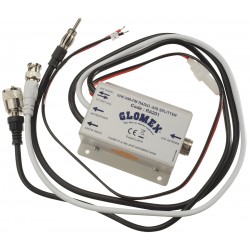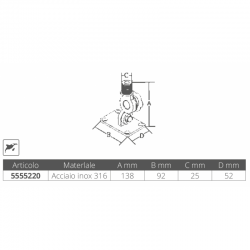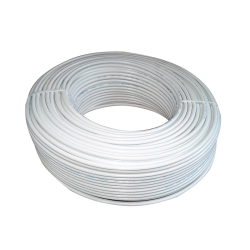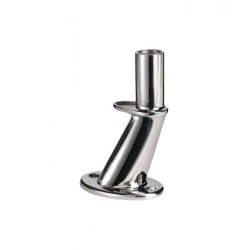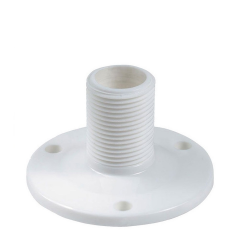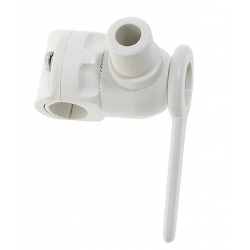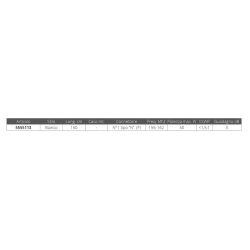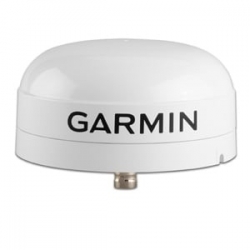Boat antenna

Welcome to the HiNelson e-commerce page dedicated entirely to marine antennas : here you can find the best equipment for boats of any size and type, both sailboats and motorboats. Glomex antennas undoubtedly reign supreme in this special category, and it's no coincidence that they have been the preferred choice of the most important international shipyards for years.
The term " Glomex antennas " is already a guarantee, and seasoned sailors know this all too well. But that doesn't mean choosing the perfect Glomex antenna for your boat is child's play: as you can see on this very page, the selection is wide and diverse, and so it's worth thoroughly researching the features of each individual marine antenna, so you can then choose the one best suited to your needs.
And that's precisely why we wanted to create this little guide: here you'll find all the essential information for choosing your Glomex TV antenna – and if that's not enough, of course, you can count on our assistance: just click the appropriate button at the bottom right to leave a message and we'll respond as soon as possible!
Glomex Antennas – Ravenna: the best marine antennas
The Ravenna-based Glomex logo doesn't shy away from subtlety: the slogan is straightforward, confident, and proud, declaring their products to be "The best in marine antennas." After all, Glomex antennas weren't born yesterday. No, sir: the Ravenna-based company has been in business since 1984, founded by Piero Baldessari. The brand, in short, is well over thirty years old, and its experience is accompanied by a constant pursuit of innovation, strengthened by Pietro's iron will—who, as he likes to point out, was trained "at the university of the docks," working for years in shipyards.
From the very beginning, the company's mission has been to produce quality marine antennas, allowing boaters to seamlessly connect to all types of maritime telecommunications. And as we all know, those who work hard and invest wisely in research and human resources, always ensuring a high level of efficiency, are destined to expand their reach year after year. Today, Glomex TV antennas are appreciated everywhere, enjoying stable relationships with manufacturers and distributors worldwide.
The real strong point of Glomex Antennas
Reliability, high technology, sophisticated design, efficiency, durability, and a wide range of options—there are countless advantages to purchasing Glomex antennas. However, if we were to name one feature that, more than any other, can outperform the competition in marine antennas, it would certainly be the lifetime warranty on all products: no other company in this sector offers such a guarantee.
And why is the Ravenna-based company Glomex able to do this? Why does a Glomex TV antenna come with a lifetime warranty, while other brands can't offer anything remotely comparable? It's easy to explain. This is possible because behind every Glomex antenna lies a meticulous and painstaking selection of the raw materials used to manufacture the devices. There's constant research to develop the best marine antennas, and ongoing daily checks ensure they always deliver the best, in full compliance with international standards.
Buy Glomex mobile antennas online
There's certainly no shortage of Glomex distributors, both in Italy and around the world. But why bother searching for physical stores when you can conveniently purchase your Glomex TV antenna online? Just two clicks and you're done, with the opportunity to take advantage of generous discounts. And that's not all, as the company is also renowned for carefully packaging each individual product, which is shipped and delivered in special packaging to eliminate any customer concerns. Given the quality of the product, it would be absurd to jeopardize its integrity through careless shipping!
Glomex TV antennas: omnidirectional antennas, directional antennas, and satellite antennas
When it comes to Glomex TV antennas, you're essentially faced with a choice between three different technologies: omnidirectional antennas , directional antennas, and satellite antennas . While everyone already knows the difference between satellite antennas and other devices, we'd like to highlight the difference—unknown to most—between omnidirectional and directional antennas.
Omnidirectional antennas are devices that receive signals from all directions, and therefore 360 degrees. Directional antennas, however, require careful orientation, as they only receive signals in a specific direction, within a 60-degree range.
Which is better, an omnidirectional antenna or a directional antenna? Well, anyone who understands telecommunications knows very well that, receiving from any direction, an omnidirectional antenna can't have much gain. A directional antenna, on the other hand, is limited to a narrow 60-degree angle, and for this reason, it proves to be three times more effective than its wide-field counterparts.
To obtain the maximum signal and thus enjoy an optimal signal, the directional antenna can be easily oriented simply by using the remote control.
Marine antennas: what does profit mean?
When discussing Glomex antennas, we discussed gain , one of the main parameters to consider when purchasing a receiving device. Starting from the fundamental assumption that an 'antenna' can be defined as any device capable of capturing electromagnetic waves radiated into space and then converting them into an electrical signal, an antenna's gain, expressed in dB or dBi, is a value that gives us a fairly clear idea of the device's effective reception—and transmission—capacity.
However, it would be simplistic to think that an antenna with a higher gain is automatically the best overall antenna. This isn't actually the case: without looking at complex mathematical formulas, we can simply remember that an antenna's gain is the ratio between the power density radiated in a specific direction and the power density that could be generated in the same direction by an isotropic radiator.
It should be emphasized, however, that the isotropic radiator, also known as an isotropic antenna or elementary diipole, actually corresponds to a theoretical mathematical model. In short, it does not exist in reality, and could never be built, as it is a device that radiates uniformly, with the same intensity, in any direction.
Based on these assumptions, we can confidently say that a higher-gain antenna is not always preferable. Indeed, a 12 dBi omnidirectional antenna, while radiating better than an 8 dBi antenna perpendicular to its longitudinal axis, ends up radiating much less in other directions. Therefore, it's not a question of an absolute "better" or "worse" value, but rather a figure that should be considered in relation to the specific use.
Glomex antennas: maximum quality, starting from the materials used
The success of Glomex antennas is also due to the quality of the materials used to manufacture them. All nautical antennas are made of the special plastic material ASA, or acrylonitrile-styrene-acrylate. For those familiar with thermoplastic materials, it's enough to know that it's an amorphous polymer from the styrene family. However, those looking to buy Glomex antennas don't need theoretical definitions. What matters is that this material offers excellent hardness and good mechanical properties. But that's not all. Unlike many other plastics, the ASA used to construct these nautical antennas is not subject to the typical deterioration processes caused by atmospheric agents and the marine environment.
Glomex antennas, in short, are resistant to the annoying yellowing that is typical of many other lower-quality devices. It's therefore not surprising that ASA is replacing high-impact polystyrene (HIPS) in most outdoor applications, precisely because of its greater resistance, especially to adverse weather conditions. Once installed on your boat, Glomex TV antennas maintain their beautiful, glossy white color, without compromising the vessel's aesthetics.
Buying a Glomex antenna: what's in the box?
Once you've purchased the Glomex antenna best suited to your needs, all you have to do is wait for the package to arrive directly at your home. But what will come with the antenna? What's in the package? In addition to the antenna itself, the price includes a 20-meter coaxial cable—reduced to 10 meters for certain Glomex omnidirectional TV antenna models, such as the Avior VT3000—as well as any tools needed to install the connectors that are delivered.
Glomex satellite TV antennas
In addition to traditional directional and omnidirectional TV antennas, Glomex offers a wide range of satellite TV antennas. The offering was subsequently expanded with the introduction of second-generation digital video broadcasting—often abbreviated to DVB-S2—which allows boaters to receive a highly satisfactory television signal, allowing them to enjoy Full HD and 4K channels even at sea.
The specific aim of Glomex satellite antennas is the elimination of noise, which, combined with the innovative high-performance parabolic dishes, ensures total and enviable silence, eliminating disturbances linked to the progressive increase in the number of satellites in orbit.
Satellite dishes: what is DVB-S2?
Glomex satellite TV antennas, as mentioned, have made a leap forward in the world of nautical telecommunications, moving to DVB-S2. But what exactly are we talking about? The simple abbreviation DVB-S refers to any satellite television broadcast. We're therefore talking about transponders with an average capacity of about 40 Mbps: with these values, it's usually possible to transmit no more than 10 standard channels on the same frequency, or, in the case of HD broadcasts, no more than 5 channels. The more channels broadcast on the same transponder, the lower the quality of the broadcast.
We can therefore understand the reasons that led to the development of DVB-S2, which precisely expands the bandwidth of the transponders: we are no longer talking about 40 Mbps, but rather 65 Mbps. With these figures, up to 10 HD channels can be transmitted on the same frequency, a goal simply unthinkable at the previous stage.
Glomex Antennas: Answers to Common Questions
- Where is it best to install the Glomex TV antenna?
There are no hard and fast rules for installing these devices on your boat, but rather a single general rule: Glomex TV antennas must be installed high up, away from any possible signal obstruction.
- Where to install marine antennas on sailboats?
In the case of sailing boats, the best place to install a Glomex antenna is without a doubt the masthead, using the appropriate support.
- Can there be interference between the radar and the antenna?
Absolutely yes: for this reason it is necessary to install the antenna on a different level from the radar, so as to eliminate any type of mutual interference.
- Is it difficult to connect the connector to the base of the antenna?
Absolutely not: inside the Glomex marine antenna package you will also find a special tool, with which you can easily screw the connector.
- How many televisions can be connected to a single Glomex TV antenna?
This depends on the splitter used: by connecting to a V9147 splitter the maximum number of devices is two, while with a 50022 splitter it is possible to reach up to 6 televisions.
- The coaxial cable I have isn't long enough. What can I do?
There are two options: you can extend the existing cable with another cable, connecting the two via an F connector. This, however, will result in a loss of gain, which will decrease with each additional connection. The second, more effective, method involves replacing the existing coaxial cable with a longer one: this will not compromise signal quality.
- Where to install the amplifier?
The amplifier should be installed in a dry, well-ventilated place that allows easy access to the gain knob (which should be adjusted to eliminate any factors that may negatively affect signal reception).




